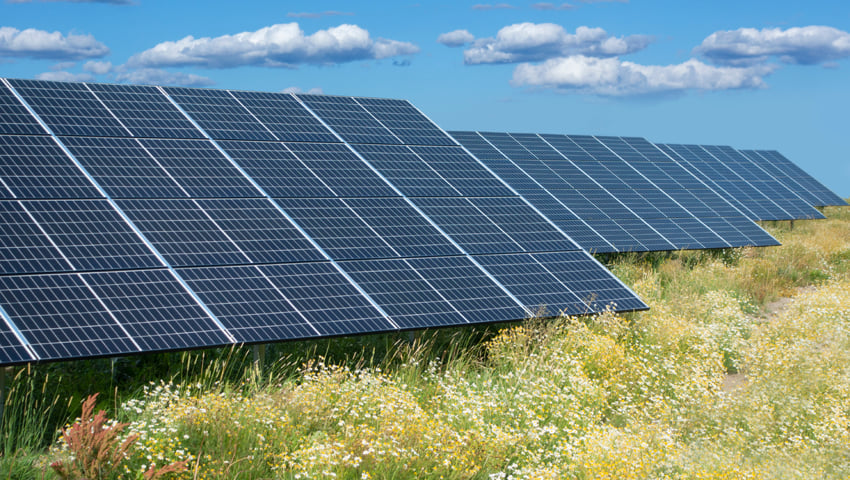By Jane Crichton, Associate Planning Director, Lanpro, offers advice for landowners
In May, prior to the general election, the then Energy Security Secretary told Parliament that large solar projects should not be located on ‘Best and Most Versatile’ land.
This came at a time when many landowners were considering solar as a means of diversification and so the policy change raised several questions: were the changes necessary? To what extent should food security be prioritised over energy security? Is it necessary for solar farms and food security to be mutually exclusive? And can solar represent an opportunity for landowners?
It is a common misconception that solar farms are a threat to national food security. Food security and renewable energy are not mutually exclusive and the many other factors that are a threat to food security include climate change.
Following July’s election we now have a new Secretary of State (Ed Miliband) and a newly named government department (the Department of Energy Security and Net Zero).
Fortunately the new minister has a different position on this issue.
Ed Miliband recently spoke out about the misconceptions that surround solar farms and their threat to food security. He said that ground-mounted solar was estimated to take up 0.1% of UK land in 2022. Clearly, this is a very small amount of land being taken out of production. Added to which, the use of fields for solar is only ever for a temporary period.
In addition, solar farms can be stacked with food production activities, for example sheep grazing, cattle grazing (dependent of the height of the panels), bee-keeping, and even, in more innovatively-managed systems, row cropping, viniculture or fruit production.
The change in government policy is a good opportunity for landowners in England. From individual households to multi-hectare sites of several hundred megawatts (MW), individuals and companies have been profiting from solar for decades, while also supporting regional and national targets for reducing carbon emissions to net zero by 2050.
Profitability is difficult to gauge as it is determined by many factors, including the scale of the development, proximity to a grid connection (substation or overhead lines) and the suitability and orientation of the land. That said, the average return on investment for a solar farm in the UK is believed to between 10 to 20%. And thanks to technology, cost efficiency is increasing rapidly due to innovations such as tracking panels which follow the sun and bifacial panels which process light from more than one angle. As an indication, however, a site of 25 acres would produce approximately to 5 MW, which is enough to power 10,000 homes and businesses. As an indication of cost, the average solar farm (taking into account panel and inverter costs) costs around £375,000 per megawatt-hour (MWh) of electricity produced.
It is rarely the case that this initial investment would fall to the landowner alone, as most solar farms are financed by investment consortiums, typically including an investor and the solar energy provider. Grants are also available, and as solar gains more political support we expect to see community trusts and a range of other organisations taking a renewed interest. The positive change in policy will also result in smaller arrays becoming more profitable than previously – and therefore an increase in investor interest in such schemes.
The process of gaining planning consent for a solar farm in England is proposed to change over the next few months. The government has stated in its revised National Planning Policy Framework (NPPF) consultation that it is considering increasing the threshold by which solar farms can be considered under the Town and Country Planning Act route, from under 50MW up to 150MW.
This is good news for landowners considering a solar development on any amount of land up to approximately 300 hectares.
Essentially, it means that the long, drawn-out process of applying for planning consent under the Nationally Significant Infrastructure Project (NSIP) regime would be replaced with a planning application direct to the local planning authority. Under this process, the extent of public consultation and many other factors are reduced and simplified, which should result in the decision being made faster and more cheaply, although this is dependent on local planning authorities having the resources and appetite for this increased scale of development.
Furthermore, the new government’s more proactive approach to development on the Green Belt means that farmland which falls within the Green Belt and meets the potential new tests set out in the consultation version of the NPPF is unlikely to face the same policy hurdles as it did just a few months ago.
Alongside utilising some Green Belt land, the government is also committed to biodiversity and there is no doubt that the development of a solar farm is an excellent opportunity to introduce biodiversity improvements.
All of the solar projects that Lanpro has worked on have incorporated areas of wildflower meadows, pasture or meadow grassland, hedgerows and wetland habitat creation – each providing substantial benefits for wildlife. This will bring significant biodiversity which in turn has an impact on food production. The operator of a bee keeping business is also involved with training people to develop bee keeping skills.
And, importantly, solar and food production need not be mutually exclusive: it is commonplace for livestock, specifically sheep to graze on the land post construction.
But indicators to date suggest that the new government understands the complex relationship between energy production and food production in such a way that will benefit both. We look forward to the publication of the new NPPF later this year and for more opportunities to work with landowners in bringing about significant opportunities.
